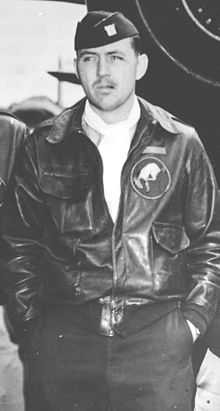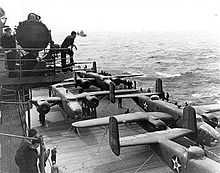Ted W. Lawson
| Ted W. Lawson | |
|---|---|
 Major Lawson | |
| Born |
March 7, 1917 Alameda, California |
| Died |
January 19, 1992 (aged 74) Chico, California |
| Place of burial | Chico Cemetery Mausoleum |
| Allegiance | United States of America |
| Service/branch | United States Army Air Forces |
| Years of service | 1940–1945 |
| Rank | Major |
| Unit | U.S. Air Mission, Santiago, Chile |
| Commands held | Liaison Officer |
| Battles/wars |
participated in Doolittle's Tokyo raid, 1942 World War II |
| Awards |
Distinguished Flying Cross Purple Heart Chinese Army, Navy, and Air Corps Medal, Class A, 1st Grade |
| Other work | Author |
Major Ted William Lawson (March 7, 1917 – January 19, 1992) was an American officer in the United States Army Air Forces, who is known as the author of Thirty Seconds Over Tokyo, a memoir of his participation in the Doolittle Raid on Tokyo in 1942. The book was subsequently adapted into a film of the same name starring Spencer Tracy, Van Johnson and Robert Mitchum.
Early life
Lawson was born in Alameda, California and attended Los Angeles City College. He joined the then- U.S. Army Air Corps in March 1940 while employed by Douglas Aircraft Company and received his pilot's wings and commission as a Second Lieutenant on 15 November 1940.[1]
World War II

In early 1942, Lawson, then a First Lieutenant, was assigned to the 17th Bomb Group (Medium), flying antisubmarine patrols out of Pendleton, Oregon. The 17th was the first Army Air Corps group to receive the B-25 Mitchell and had the most experienced pilots, so was ordered from Oregon to Lexington County Army Air Base at Columbia, South Carolina, ostensibly to fly similar patrols off the East Coast of the United States but in actuality to prepare for the mission against Japan. The group officially transferred effective 9 February to Columbia, where its combat crews were offered the opportunity to volunteer for an "extremely hazardous" but unspecified mission. On 17 February the group was detached from the Eighth Air Force. Lieutenant Lawson was accepted as a volunteer for the mission led by then-Lieutenant Colonel Jimmy Doolittle to bomb Tokyo and several other cities with 16 carrier-launched B-25 Mitchell bombers from aboard the USS Hornet (CV-8) - the first air raid on mainland Japan during World War II following the Pearl Harbor attack. The aircraft that he flew on the raid was nicknamed "The Ruptured Duck" (AAF serial 40-2261). According to Lawson in his book, the plane's unusual name evolved from a minor training accident where the aircraft tail scraped the ground on take-off. Soon after Lawson found someone had written "ruptured duck" in chalk on the fuselage. Inspired, he had a crewman create the now-famous caricature of Donald Duck with crutches and pilots headphones.
After launching the mission 170 miles (275 km) further out than planned and bombing their targets in Japan, all of the aircraft ran out of fuel short of their intended recovery airfields in non-Japanese occupied China. Lawson and his crew were forced to ditch their plane off the coast of the small island of Nantien. Lawson and his co-pilot were both thrown clear of the B-25, with Lawson suffering a severely lacerated left leg in the process. All five crew members survived the crash; however all but flight engineer/gunner David J. Thatcher received serious injuries. Bombardier Robert Clever would be returned to the U.S., only to die in another plane crash in November, 1942. After he was transported by friendly Chinese throughout several provinces in China, Lawson's infected leg was amputated by the mission's flight surgeon, Lt Thomas R. White. The nose art of the crashed bomber, "The Ruptured Duck", was later salvaged by the Japanese and put on display in Tokyo.
Author
In January 1943, Lawson and newspaper columnist Bob Considine decided to write a book about the mission, entitled Thirty Seconds Over Tokyo. In four nights and two days in the Mayflower Hotel in Washington, the entire story was worked out. Through friends in the Los Angeles area, Ted made contact with Metro-Goldwyn-Mayer producer Sam Zimbalist, and the movie was launched in 1944. The film starred Van Johnson as Lawson, alongside Spencer Tracy and Robert Mitchum. It won an Academy Award for Best Special Effects.[2] In 2003, Brassey's reprinted Thirty Seconds Over Tokyo with more photos and an introduction from Lawson's widow, Ellen.[3]
Later life
Along with the majority of the surviving Doolittle Raiders, Lawson was eventually repatriated back to the United States, and in his case, for further medical care. After leaving the hospital, Lawson was promoted to captain, and later to major. He served as Liaison Officer, U.S. Air Mission, Santiago, Chile from May 1943 until April 1944. He was retired from the U.S. Army Air Forces for physical disability on February 2, 1945. His decorations include the Distinguished Flying Cross, Purple Heart, and the Chinese Army, Navy, and Air Corps Medal, Class A, 1st Grade.
After the war, Lawson owned and operated a machine shop in Southern California, and also worked for Reynolds Metals as a liaison between the company and the military. He died at his home in Chico, California on January 19, 1992 and was interred at the Chico Cemetery Mausoleum.
Honors and tributes
Lawson Army Airfield at Fort Benning, Georgia is partially named for Ted W. Lawson. It was originally named only for Walter R. Lawson (no relation to Ted), an Army Air Corps flyer who earned the Distinguished Service Cross in World War I. Several years later, after the Doolittle Raid in World War II, Ted W. Lawson's name was added to the memorial at the field.[4][5]
The Pacific Aviation Museum Pearl Harbor, located on Ford Island, has on display a B-25 done in the livery of Lawson's aircraft from the Doolittle Raid.
See also
References
- Notes
- ↑ "Ted W. Lawson: Biography." imdb.com. Retrieved: February 3, 2010.
- ↑ "Thirty Seconds Over Tokyo (1944)." IMDb. Retrieved: November 19, 2011.
- ↑ Lawson, Ted W. "Thirty Seconds Over Tokyo (book)." google.com. Retrieved: February 3, 2010.
- ↑ "Walter Ralls Lawson Sr., Captain, United States Army Air Service." Arlington National Cemetrary. Retrieved: September 1, 2010.
- ↑ "Lawson Army Airfield." globalsecurity.org. Retrieved: September 1, 2010.
- Bibliography
- Chun, Clayton K.S. The Doolittle Raid 1942: America's First Strike Back at Japan (Campaign: 16). Botley Oxford, UK: Osprey, 2006. ISBN 1-84176-918-5.
- Glines, Carroll V. The Doolittle Raid: America's Daring First Strike Against Japan. New York: Orion Books, 1988. ISBN 0-88740-347-6.
- Lawson, Ted W. Thirty Seconds Over Tokyo. Dulles, Virginia: Brassey's Inc., 2003 (60th anniversary reprinted edition). ISBN 1-57488-508-1.
- Watson, Charles Hoyt. DeShazer: The Doolittle Raider Who Turned Missionary. Winona Lake, Indiana: The Light and Life Press, 1950.
External links
|